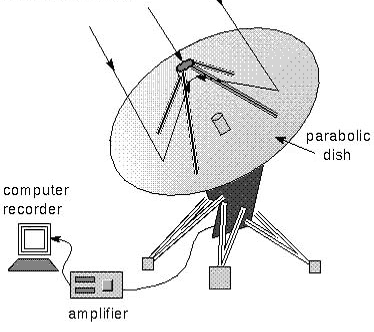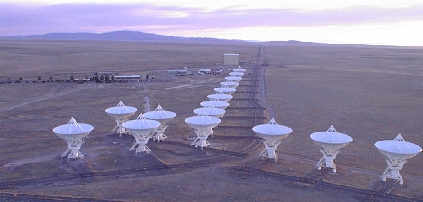 Radio telescopes are mainly either prime focus or Cassegrain reflectors.
Radio telescopes are much larger than optical telescopes. The angular resolution
of a telescope is proportional to the wavelength divided by its diameter.
In order for a radio telescope to be able to detect the same angular resolution
as an optical telescope the radio telescope has to be much larger.
Radio telescopes are mainly either prime focus or Cassegrain reflectors.
Radio telescopes are much larger than optical telescopes. The angular resolution
of a telescope is proportional to the wavelength divided by its diameter.
In order for a radio telescope to be able to detect the same angular resolution
as an optical telescope the radio telescope has to be much larger.
The parts of a Radio Telescope
There are four basic elements to a radio telescope.
The reflector (or dish) collects power from astronomical sources.
The subreflector is a surface that directs the radiation to
the feed (or antenna) at the center of the reflector. Behind the feed is the
receiver (or amp) system (at the cassegrain focus).
The receiver amplifies
the radio signal and selects the appropriate frequency range that
detects the signal.

|

|
The Largest Radio Telescope in the World
Nestled in the central mountains of Puerto Rico,
the primary reflector of the Arecibo
Observatory is three football fields wide! The dish
is made of a small mesh, which
allows rain to fall through and plants below it
to flourish. The 305-m reflector
dish is spherically shaped and can not be moved
or pointed. Pointing in the sky
and corrections for spherical aberration are made
at the subreflector (also the receiver), weighing 900
tons and suspended 450 feet above the dish.
 Using arrays of radio telescopes
Using arrays of radio telescopes
The Very Large Array (VLA) near Albuquerque, NM, combines the signal
received from 27 different dishes to try and create one super dish. It does
so by correlating the signals arriving at the different telescopes while
the Earth rotates and sweeps through a large number of
source-telescope orientations.